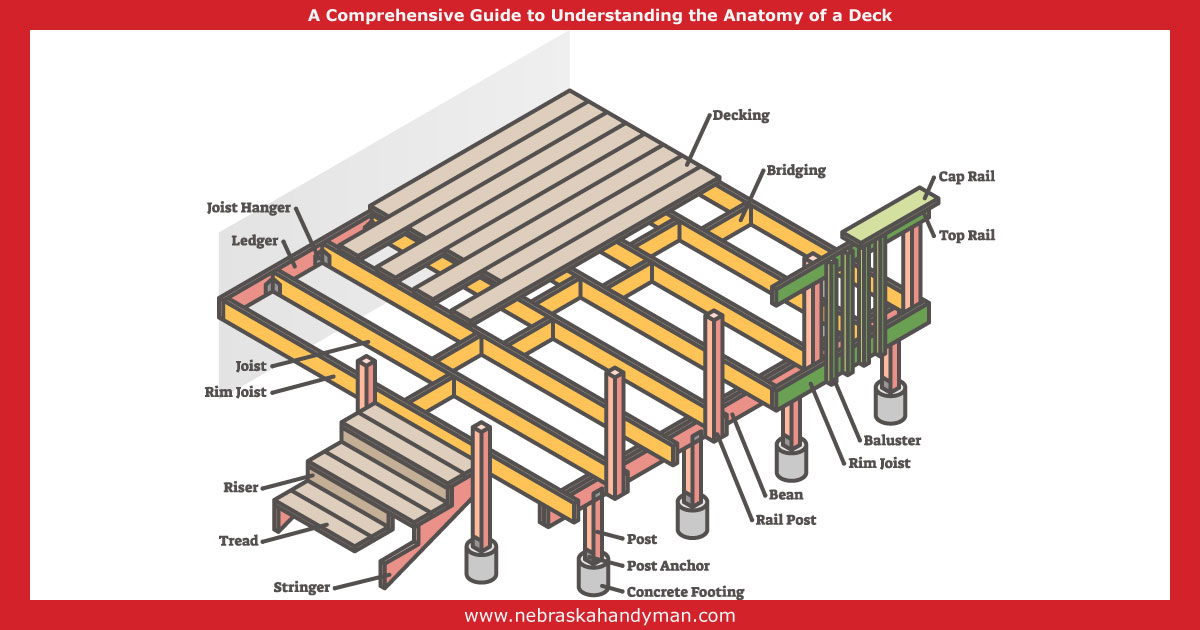Decks are marvelous additions to any home, providing an outdoor oasis for relaxation, entertainment, and leisure. Whether you're planning to build a deck yourself or simply seeking a deeper understanding of deck construction, it's essential to familiarize yourself with the various components that make up a sturdy and safe deck structure. In this article, we will explore each part of a deck, shedding light on their purposes and functions, and empowering you with the knowledge needed to make informed decisions about your deck project.
Footing
The footing is a crucial component of a deck's foundation, typically made of concrete and buried beneath the ground. It provides stability and support for the entire structure by transferring the weight of the deck and its occupants to the soil, ensuring that the deck remains level and secure.
Post
Posts are vertical members that support the deck's structure and are usually made of wood or metal. They are securely anchored to the footings and provide stability and load-bearing capacity for the deck. Posts also serve as attachment points for beams and joists, helping to distribute the weight evenly across the structure.
Ledger Board
The ledger board is a horizontal piece of lumber attached to the exterior wall of a building, acting as the primary connection point between the deck and the house. It provides support and stability to the deck by transferring the weight of the structure to the wall studs. Proper installation and attachment of the ledger board are essential for a safe and structurally sound deck.
Beam
Beams are horizontal load-bearing members that run parallel to the ledger board and provide support for the joists. They are typically larger in size and made of multiple pieces of lumber or engineered wood. Beams distribute the weight of the deck evenly across the posts, ensuring the structural integrity of the entire deck system.
Joist
Joists are horizontal members that span between the beams and provide the framework for the deck's surface. They are typically made of wood or steel and are spaced apart to support the deck boards. Joists play a critical role in distributing the load and preventing sagging or bouncing of the deck, ensuring a safe and stable platform.
Rim Joist
The rim joist, also known as the perimeter joist, is a piece of lumber that runs along the outer edge of the deck, perpendicular to the joists. It completes the deck's framework and provides lateral support, preventing the deck from twisting or shifting. The rim joist also acts as a connection point for the deck boards and helps create a finished look.
Deck Board
Deck boards are the visible surface of the deck, creating the platform where people walk and sit. They are typically made of wood, composite materials, or PVC, and come in various sizes, colors, and patterns. Deck boards are fastened to the joists and provide a durable and aesthetically pleasing surface for outdoor activities and relaxation.
Stringer
Stringers are diagonal or zigzag-shaped structural supports that are used to create stairs in a deck. They are typically made of wood or metal and provide stability and weight-bearing capacity for the steps. Stringers are essential for ensuring safe and functional staircases within a deck structure.
Railing Post
Railing posts are vertical supports that hold the railing in place and provide safety and security on the deck. They are typically attached to the deck surface or secured to the joists or beams. Railing posts play a critical role in preventing falls and providing stability along the perimeter of the deck.
Railing
Railings are horizontal or vertical barriers that enclose the deck, providing additional safety and aesthetics. They are typically made of wood, metal, glass, or composite materials. Railings serve as handholds and prevent accidental falls, especially for elevated decks. They can be customized in various designs and styles to complement the overall deck architecture.
Baluster
Balusters, also known as spindles or pickets, are vertical supports installed between the railing and the deck surface. They provide safety by preventing the passage of people or objects through the railing gaps. Balusters come in different materials, shapes, and sizes, and their design significantly contributes to the deck's appearance.
